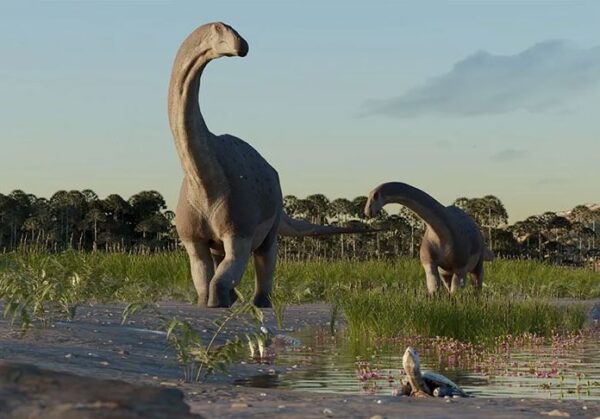On April 11, Argentina’s National Council of Scientific and Technical Research (Conicet) announced that paleontologists in this country had discovered a new species of dinosaur belonging to the genus titanosaur, a genus of sauporod dinosaurs. Herbivores have small heads and large bodies.
A reporter in Buenos Aires quoted Conicet’s announcement as saying that this new species of dinosaur lived in the Patagonia region of Argentina 66 million years ago, right before the Cretaceous-Paleogene extinction that marked the end of ” “dynasty” of dinosaurs on Earth.
Argentine scientists have named the newly discovered species “Titanomachya gimenezi”, with a meaning reminiscent of the Titanomachy battle in Greek mythology, where the gods fought against titan giants. Along with that, the name of the new dinosaur also honors Olga Giménez, the first paleontologist to discover dinosaur fossils in Chubut province in southern Argentina.
Conicet researcher Agustín Pérez Moreno said the fossils of this new titanosaur were found in thick sediments in the “La Colonia Formation” in Chubut province.
“Titanomachya gimenezi” weighs about 7 tons, much smaller than the species “Patagotitan mayorum” also belonging to the titanosaur genus, which lived about 95 – 100 million years ago in the Patagonia region. Fossils of the species “Patagotitan mayorum” were discovered for the first time in Neuquén province, showing that the titanosaur weighed up to 70 tons, was 37 m long and nearly 6 m high.
In the case of “Titanomachya gimenezi”, Aregntina paleontologists determined the existence of this species based on the morphology of the astragalus, a type of bone in the hind legs of dinosaurs. Scientists have successfully recovered parts of the species’ forelimbs and hind limbs, as well as fragments of its ribs and tail vertebrae.
Mr. Pérez Moreno emphasized that until “Titanomachya gimenezi” was discovered, scientists had never found any fossils of the sauropod dinosaur family in the “La Colonia Formation” – which is a “graveyard”. of many ancient creatures, from carnivorous dinosaurs and plesiosaurs to turtles and other reptiles.
Therefore, this scientist affirms that “the findings at La Colonia not only provide important information about the sauropod population of Patagonia at the end of the Cretaceous period, but also about the diversity of the regional ecosystem at that time. there”.
About 66 million years ago, the ecosystem in humid Patagonia had diverse aquatic flora, palm trees and coniferous forests, thereby providing the perfect habitat for large herbivorous dinosaurs.











